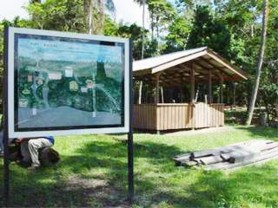Minister of Culture, Youth and Sport Dr Frank Anthony recently visited Fort Nassau as plans take shape to renovate the monument and make it attractive to locals and tourists.

According to a Government Information Agency (GINA) Fort Nassau was built with wood and enclosed with palisades, an irregular rectangular redoubt, a barrack to house about 60 soldiers and a main building where the governor, captain, secretary and lieutenants lived. Only the foundation of the above structures remain today, and according to the minister, the National Trust which is tasked with preserving historic sites will be working to safeguard the area.
The National Trust had erected signs as part of its preservation work previously however, most had been destroyed and efforts will be made to erect more durable ones. Plans are also in train to renovate the small landing area which provides access from the Berbice River.
Anthony said the objective is to make Fort Nassau an attractive location for visitors and tourists. “We want to make [it] into a site where people can go and learn about the history so that they can be easily guided around the site,” he said. Anthony admitted that the magnitude of work is great and said it will be accomplished in phases; similar to the renovation works done on Fort Zeelandia and the Court of Policy Hall, on Fort Island in the Essequibo River.
In 1999 Fort Zeelandia and the Court of Policy Hall, Fort Nassau, Fort Kyk-Over-Al, Red House, St George’s Cathedral, the 1763 Monument, the Non-Aligned Monument, Umana Yana and the African Liberation Monument were declared national monuments. The Trust also recently started a new initiative of erecting interpretive heritage markers/signs at several historic sites in Guyana. The signs provide information on the historical background and significance of the site.
GINA said the Fort located on the eastern bank of the Berbice River has its genesis in 1697 when it was built by Dutch merchant Abraham Van Pere. It served as the seat of the government in Berbice and was also the location from where the 1763 slave rebellion led by Cuffy was initiated.








